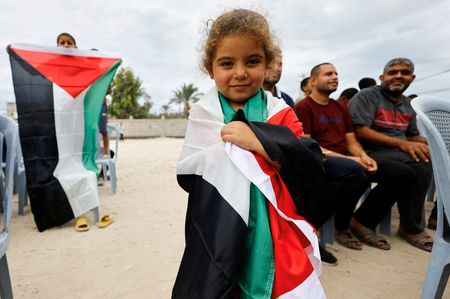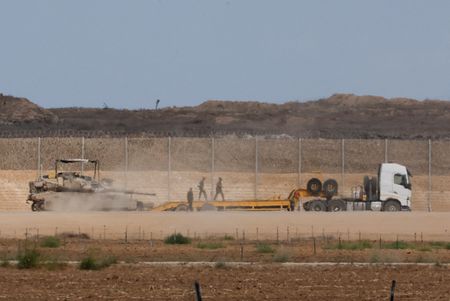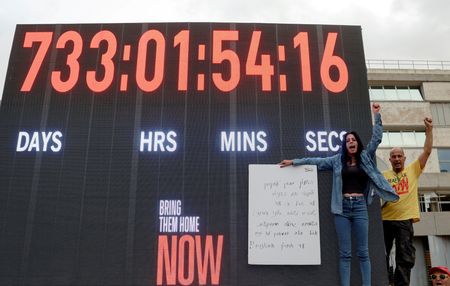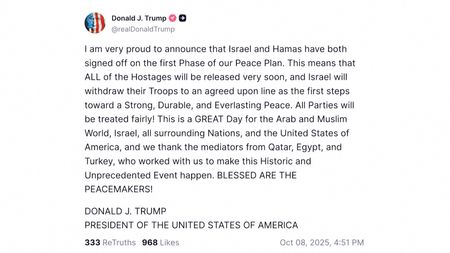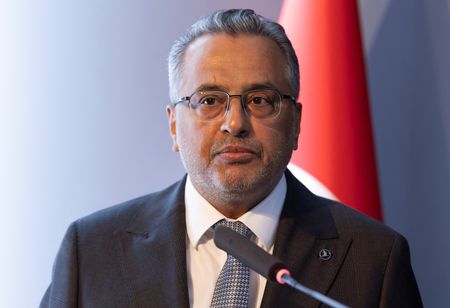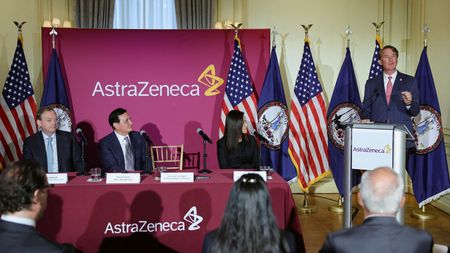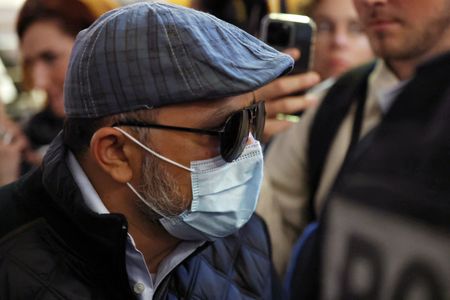By Maayan Lubell and Nidal al-Mughrabi
JERUSALEM/CAIRO (Reuters) -Israel and the Palestinian militant group Hamas signed an agreement on Thursday to cease fire and free Israeli hostages in exchange for Palestinian prisoners, in the first phase of U.S. President Donald Trump’s initiative to end the two-year war in Gaza that has upended the Middle East.
Israelis and Palestinians alike rejoiced after the deal was announced, the biggest step yet to end two years of war in which over 67,000 Palestinians have been killed, and return the last hostages seized by Hamas in the deadly attacks that started it.
Officials on both sides confirmed they had signed the deal following indirect talks in the Egyptian beach resort of Sharm el-Sheikh.
Under the deal, fighting will cease, Israel will partially withdraw from Gaza, and Hamas will free all remaining hostages it captured in the attack that precipitated the war, in exchange for hundreds of prisoners held by Israel. At the White House, Trump said he believed it would lead to “lasting peace.”
Fleets of trucks carrying food and medical aid would be allowed to surge into Gaza to relieve civilians, hundreds of thousands of whom have been sheltering in tents after Israeli forces destroyed their homes and razed entire cities to dust.
HURDLES REMAIN
Israeli Prime Minister Benjamin Netanyahu’s security cabinet convened ahead of an expected meeting by his full government to ratify the deal, Israeli media reported. Netanyahu said the ceasefire would take effect after ratification.
The accord, if fully implemented, would bring the two sides closer than any previous effort to halt a war that has evolved into a regional conflict, drawing in Iran, Yemen, and Lebanon, and deepened Israel’s international isolation.
Much could still go wrong. Even after the deal was signed, a Palestinian source said the list of Palestinians to be released had yet to be finalised. The group is seeking freedom for some of the most prominent Palestinian convicts held in Israeli jails, as well as hundreds of people detained during Israel’s assault.
Further steps in Trump’s 20-point plan have yet to be discussed, including how the shattered Gaza Strip is to be ruled when the fighting ends, and the ultimate fate of Hamas, which has so far rejected Israel’s demands it disarm.
But the announcement of an end to fighting and return of hostages was greeted with jubilation.
‘ALL OF THE GAZA STRIP IS HAPPY’
“Thank God for the ceasefire, the end of bloodshed and killing,” said Abdul Majeed Abd Rabbo in Khan Younis in southern Gaza. “I am not the only one happy, all of the Gaza Strip is happy, all the Arab people, all of the world is happy with the ceasefire and the end of bloodshed.”
Einav Zaugauker, whose son Matan is one of the last hostages, rejoiced in Tel Aviv’s so-called Hostages Square, where families of those seized in the Hamas attack that triggered the war two years ago have long assembled.
“I can’t breathe, I can’t breathe, I can’t explain what I’m feeling … it’s crazy,” she said, speaking in the red glow of a celebratory flare.
In Gaza, Israeli strikes and shooting continued on Thursday before the official start of the ceasefire, but at a slower pace than in recent weeks when Israel was conducting one of its biggest offensives of the war.
The Gaza health ministry said at least three Palestinians were killed by Israeli fire during the day on Thursday after reporting nine killed in the previous 24 hours, far fewer than the scores killed daily in recent weeks.
There were already signs on the ground of Israeli troops preparing to pull back. An eyewitness near Nusseirat camp in the central Gaza Strip told Reuters that he had seen the Israeli army blow up an abandoned troop position and lower a crane used to surveil the area.
Near the Netzarim corridor, the main staging area for Israeli troops in central Gaza, the army fired dozens of smoke grenades, typically used to provide cover for troops on the move.
HOSTAGES TO BE FREED WITHIN 72 HOURS
An Israeli government spokesperson said the ceasefire would go into force within 24 hours of the government meeting. After that 24-hour period, the hostages held in Gaza would be freed within 72 hours.
Twenty Israeli hostages are still believed to be alive in Gaza, while 26 are presumed dead, and the fate of two is unknown. Hamas has indicated that recovering the bodies of the dead may take longer than releasing those who are alive.
Trump appeared likely to head to Israel around the time the hostages are due to come home, with a note from Israeli President Isaac Herzog’s office saying Herzog’s agenda for Sunday had been cleared in anticipation of a Trump visit. At the White House, Trump said he hopes to attend a signing ceremony in Egypt.
The deal received support from Arab and Western countries and was widely portrayed as a major diplomatic achievement for Trump, who cast it as a first step towards reconciliation in the wider Middle East.
Successful completion of the deal would mark a significant accomplishment for the Republican president, who has struggled to quickly deliver on his promises to bring peace to the Gaza conflict and Russia’s invasion of Ukraine.
Western and Arab countries were meeting in Paris on Thursday to discuss an international peacekeeping force and reconstruction assistance for Gaza once the fighting stops.
Netanyahu called the deal “a diplomatic success and a national and moral victory for the State of Israel.”
But far-right members of Netanyahu’s coalition have long opposed any deal with Hamas. Finance Minister Bezalel Smotrich said Hamas must be destroyed once the hostages are returned.
More than 67,000 Palestinians have been killed in Israel’s assault on Gaza, launched after Hamas-led militants stormed through Israeli towns and a music festival on October 7, 2023, killing 1,200 people and capturing 251 hostages.
(Additional reporting Pesha Magid and Alexander Cornwell in Jerusalem, Jana Choukeir and Tala Ramadan in Dubai, and Jeff Mason and Steve Holland in Washington; Writing by Michael Georgy, Peter Graff and Andy Sullivan; Editing by Timothy Heritage and Rod Nickel)

